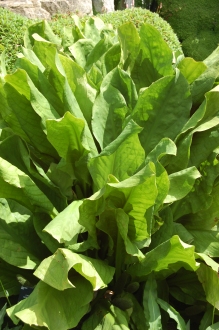Position: Full sun to partial shade
Flowering period: Late spring
Soil: Moist, poorly drained
Eventual Height: 90cm
Eventual Spread: 60cm
Hardiness: 5a, 5b, 6a, 6b, 7a, 7b, 8a, 8b,9a, 9b
Family: Araceae
Sub Family: Orontioideae
Lysichiton camtschatcensis is a clump forming deciduous herbaceous perennial that prefers boggy conditions. Its mid green glossy leaves are broadly oval with distinctive veining, appear in rosettes and are up to 90cm long. Its fragrant white flowers are lance shaped pointed spathes, these appear before the leaves and are up to 30cm in height.
Lysichiton camtschatcensis, commonly known as the Asian Skunk Cabbage or White Skunk Cabbage, is native to Japan, the Kamchatka Peninsula and islands in between. In its native habitat it is found along stream edges, and in wet woodlands and swamps.
The etymological root of the binomial name Lysichiton is derived from the Greek lusis meaning ‘loose’ and xitwn meaning ‘tunic’, in reference to spathe of this plant. Camtschatcensis is derived from the Latin meaning ‘from Kamchatka’.
The landscape architect may find Lysichiton camtschatcensis useful for marginal planting to lakes, ponds and streams, providing a mass of fragrant spring flowers.
Ecologically, Lysichiton camtschatcensis is attractive to some species of beetle who pollinate its flowers.
The Royal Horticultural Society has given Lysichiton camtschatcensis their prestigious Award of Garden Merit in 1993.
Lysichiton camtschatcensis prefers moist, fertile, humus rich, poorly drained soils. It tolerates most pH of soil.
Lysichiton camtschatcensis requires little maintenance.







Leave a comment